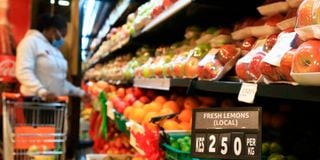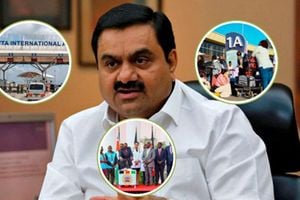How the next government can revive the economy and create jobs for the youth

A customer picks fruits at a supermarket in Nyeri on August 7, 2021. Many agricultural products are imported and yet their domestic production is viable.
The fisheries and blue economy sector is vital to revamping the economy and will require reviewing of policies, standards and norms, legislation and regulations to guide it. More funding will be set aside to fund research in the blue economy as well as to provide incentives and preference to Kenyan investors and Kenyan manufactured machines.
Manufacturing
The manufacturing sector will need to be supported through waiver of regulatory and other licensing fees for new youth-led manufacturing innovations to encourage and support technological exchanges with industries and other countries for mutual benefit. The government will need to procure and promote “Made in Kenya” products – Buy Kenya Build Kenya as well as give incentives to Kenyans including those in the diaspora and foreigners to invest in the manufacturing sector.
Energy and MSMEs
To further reduce costs of energy, a stable petroleum pricing policy needs to be rolled out and work towards attracting investments in alternative sources and renewable energy.
To reduce revenue losses, the government will intensify meter reading and restructure the supply and distribution infrastructure around power utilities. The recent restructuring of Kenya Power Company is a notable and worthwhile initiative.
The Medium Small and Micro Enterprises (MSMES) contribute 30 per cent of the GDP and will need to be supported by implementing ‘Recognition of Prior Learning’ (RPL) certification program to award certificates to artisans, craftsmen and technicians who have obtained skills and knowledge through apprenticeship and work experience to enhance their employment opportunities, by empowering their efforts - “Shahada la Jitihada”.
Housing
The government will adopt the Affordable Housing Program Jua Kali Production Manual for purposes of ring-fencing the 69 items earmarked for jua kali production with the aim of expanding local manufacturing and connect jua kali manufacturers with orders for the doors, windows, nails, hinges, and all the other 69 items, under the Affordable Housing Programme. Further, a financial institution will be created that will provide low interest credit to boda boda and other small-scale entities.
The digital economy will expand programs that connect the youth to the global networks for employment while ensuring gender equity within the ICT sector by raising awareness of the importance of female presence within the most technical areas of the digital economy by encouraging participation in STEM programs.
The youth, creative economy and sports will be supported through elaborate guidelines for a development strategy for creative commissions in rural areas so that strategy is implanted in the local population.
The government will raise public awareness on the potential of culture and creative industries to re-work the society’s attitude toward the development economy.
Medium term plans; Unemployment and job creation
Rapid population growth and urbanisation has many socio-economic implications for Kenya. In 2018, the projected urban population by 2022 was 16 million people. The Kenyan population, 75 percent of which is made up of the youth aged between 18 and 35 years, is projected to reach 66.45 million by 2030.
Unfortunately, a large percentage of this population is unemployed and are marginalised in terms of access to opportunities, representation and participation. Speaking during the session, Professor Terry Ryan, a leading economist and an advisory board member, Strathmore University, observed that if we miss out on looking at how the economy is designed and avoid thinking of the long term, then we will fail to address real problems.
These problems include how the labour force is going to absorb new entrants and map out which industries will spawn from population growth that will support economic growth. Kenya’s rapid rate of urbanisation will continue to increase pressure on housing and urban infrastructure. Housing is inadequate and the growth of slums and informal settlements are expanding. Some nations have experienced urbanisation that accompanied skills upgrading, industrialization and the expansion of the urban formal sector.
In Kenya, there is an increased demand for products related to affordable housing units. However, this demand may not translate into a rapid increase in jobs in the formal sector in Kenya.
Kenya does not generate enough savings as a country that can be channelled to increasing more white-collar jobs in the country. The jobs in the formal sector cost a fraction of jobs in the informal sector.
Kenya has a vibrant ‘Jua Kali’ sector that fills important gaps in the economy. Where professional education is scarce, expert niche experience and hands-on learning has taken over. Policies and programs to support the ‘Jua Kali’ sector must be intensified. Another glaring issue that will become increasingly difficult to tackle in the future is access to water.
The United Nations classifies Kenya as a water-scarce country since it has less than 1000 cubic metres per capita of renewable freshwater supplies. Numerous factors including global warming, contamination of drinking water and a lack of investment in water resources has aggravated the water crisis in Kenya. It will be important to map out the sources of water available to towns and cities and invest in improved water governance and infrastructure.
The Kenyan urban system is characterised by one dominant metropolis (Nairobi city) supported by five major urban centres (Mombasa, Kisumu, Nakuru, Eldoret and Thika). Other urban centres in the hierarchy of municipality, town, urban, rural and market centres are spread throughout the country.
In 2010, Kenya established a system of devolved government with 47 county governments. Urban-related policies and schemes can be biased for megacities like Nairobi. To absorb the increasing population and labour force and enhance their revenue, counties need to attract workers and build their own industries. Balanced urbanisation will require these regional capitals to play a role as regional hubs and therefore Kenya should invest in strengthening their capacity.
Long-term issues; Sustainable agricultural productivity
The war in Ukraine is battering a global food system already weakened by the pandemic and climate change.
There may be a spectre of a global food shortage due to the rising costs of staple foods present challenges for countries that heavily rely on imports.
Pastoral and marginal agricultural areas of eastern and northern Kenya have only received minimal rainfall during the March to May 2022 long rains season. While it is important to take the long-term view when devising interventions, it is also equally important to stabilise the economy in the next six months given the situation on the ground.
A point of concern for most countries in Sub-Saharan Africa is the increased likelihood of civil strife as a result of food and energy-fuelled inflation, particularly during times of heightened political instability. Supply disruptions and soaring food and fertiliser prices may call for trade policies that ensure the free flow of food across borders throughout the region. Since Kenya has limited fiscal space, policymakers may have to look at innovative solutions such as reducing or waiving import duties on stable foods in the short term.
In the long term, the most significant barriers to and opportunities for increasing long term sustainable agricultural productivity in Kenya need to be investigated. It has been proposed that agriculture and pastoralism in Kenya will cease to become a way of life and become a commercial activity in the future. Many agricultural products, such as vegetable oils, are imported and yet their domestic production is viable. Kenya imports 95 per cent of its total edible oil requirements and yet many oil-seeds such as sunflower, sim sim, soya beans, rapeseed, coconut, castor and groundnuts can be grown and processed locally. Policy decisions to assist edible oil processors to support large out-grower schemes may support local production.
In the long term, opportunities in oilseed processing industries will stimulate supply and meet some of the domestic market demand. In the short term, edible oil processors can come together to conduct joint procurements and ship in large quantities to reduce costs.
Reducing budget deficits
Unfortunately, budget deficits and a high appetite for acquiring debt in Kenya have led to irresponsible borrowing and spending. Sri Lanka, Ghana and Pakistan have all fallen like dominos in the face of global debt crises. Panellists at a symposium mulled over the recent root causes of Kenya’s current debt crisis.
As a small, open economy, Kenya cannot withstand shocks if budget deficits impose a fiscal strait-jacket over the country, reducing its capacity to withstand shocks by rolling out fiscal stimuli. Politics and fiscal responsibility are intertwined.
Mega projects such as the new expressway have to be financed and yet citizens want to ride it for free. Citizens must be socialised differently so that they realise what the implications of megaprojects are for the future and can advocate for responsible spending by elected officials.
The country must work towards curbing expenditure and acquiring fiscal discipline and accountability. The ambitions of Kenya’s Vision 2030 may need to be tempered in the face of the current economic situation as more expenditure will only plunge Kenya into further debt.
Many projects have also not been completed efficiently because of poor resource allocation and lack of operational efficiency. Corruption needs to cease to be a way of life in Kenya. It is imperative to restore confidence by formulating a credible macro- economic and fiscal framework. Expanding the tax base, tax compliance and meeting revenue targets is a crucial part of this. However, let us be responsible with the revenue we have.
Daily discipline in the management of public affairs may seem mundane but is critical to turning the tide on fiscal irresponsibility. The broad consensus is that fiscal sustainability entails policies that promote economic growth, maintain national solvency, a supportable debt position and create stable taxes that are equitable. Prudent fiscal policies and enforcement will help Kenya manage current and future pressures.
As Kenya’s gross debt crosses the Sh8 trillion’ mark, the old adage ‘Live within your means’, rings especially true for our leaders and policymakers as debt repayment costs rise and the country grapples with global shocks. While Kenya cannot rewind time, the unfolding situation highlights the urgent need for governance reforms to improve debt transparency and strengthen debt management policies and frameworks.
Mr Imanyara is a legal expert and former MP for Central Imenti. Mr Mwaniki is a consulting economist, and Mr Gichira is a social economic development expert and Professor of Entrepreneurship





